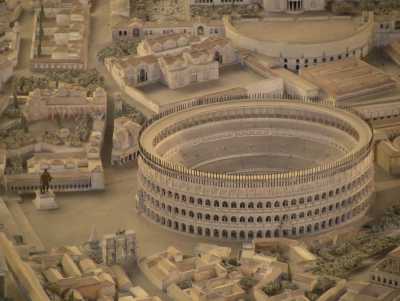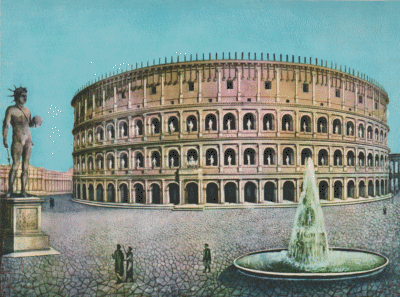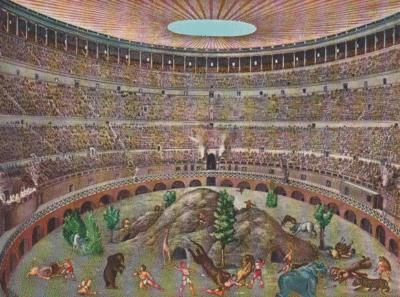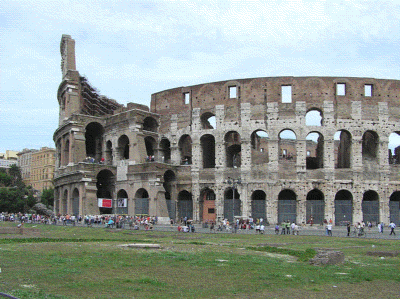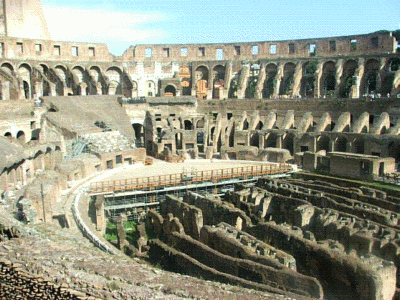 SKC Films Library |
| SKC Films Library >> Rome (City) to 476 |
| Colosseum (Coliseum) kol' i sE' um, a large building for sporting events, exhibitions, etc. artist rendering of the Colosseum
in its heyday, from above The Colosseum was begun in 72 A.D. by Emperor Vespasian, completed by his son Titus in 80 A.D., and expanded during the reign of Domitian (81-96). Officially known as the Flavian Amphitheatre under the Roman Empire, it is believed to have gotten its more common name from a huge statue of Nero that once stood nearby (applying the Latin word for "huge" or "enormous" for the general area), since it was built on the site of an artificial lake constructed by the greatly disliked Emperor. The Colosseum was for centuries the largest public building in the world. Elliptical in shape, the structure measures 615 feet in length by 510 feet in width, and its outer wall once stood 157 feet high. The inner arena is 282 feet by 207 feet, and there was once enough seating to accomodate about 50,000 spectators. Those spectators were seated according to social status, with the elite occupying the lowermost rows and the poorest the topmost (there were four separate levels). A total of eighty separate entrances were strategically placed around the perimeter and the entire facility could be emptied of people in a matter of minutes. An elaborate two-tiered structure under the arena floor (known as a hypogeum) was used for storage and the transporting of animals and fighters into an out of the arena. There was also a system of elevators and other gadgets that allowed workers to make animals and scenery "magically" appear and disappear. A retractible awning (Velarium) manipulated by slaves allowed as much as two-thirds of the arena to be sheltered from the sun or wind. The Colosseum was built as an entertainment venue, and was used in that capacity until about 435 A.D. It was the site of gladiatorial contests, sporting events, public executions, dramatic productions, animal hunts, and even full-scale mock land and sea battles. Any prominent Roman citizen with sufficient resources could sponsor an event, and some events lasted for days. Because it was built for the Roman public to enjoy, citizens of the Empire were never required to pay for admission. After the Roman Empire came to an end the Colosseum was used for housing and workshops, as a fortress, and as quarters for a religious order. Repeated damage from earthquakes had rendered the structure unsafe for use by the early 19th century, after which much of the building stone was stripped away for use elsewhere. Serious efforts to stop further deterioration did not begin until the 20th century, and a major stabilization project was completed during the rule of Benito Mussolini. street level view of the Colosseum in its heyday artist conception of a big game hunt inside the
Colosseum (note the awning) the Colosseum today inside the Colosseum
SEE ALSO |
| SKC Films Library >> Rome (City) to 476 This page was last updated on July 09, 2018. |
